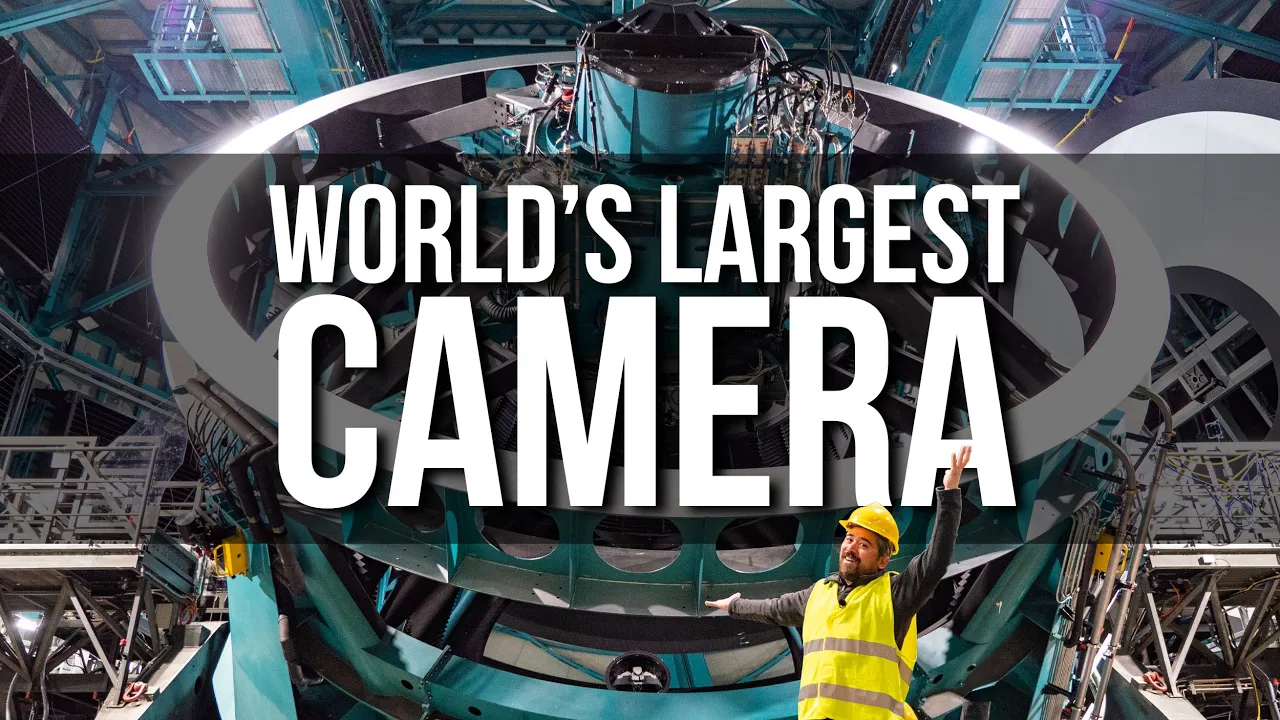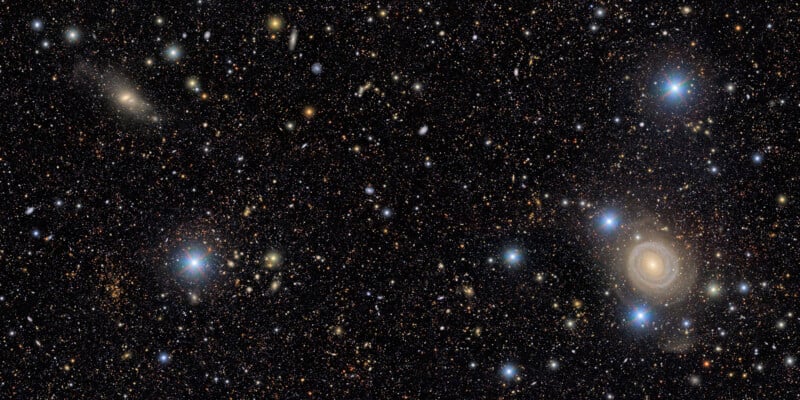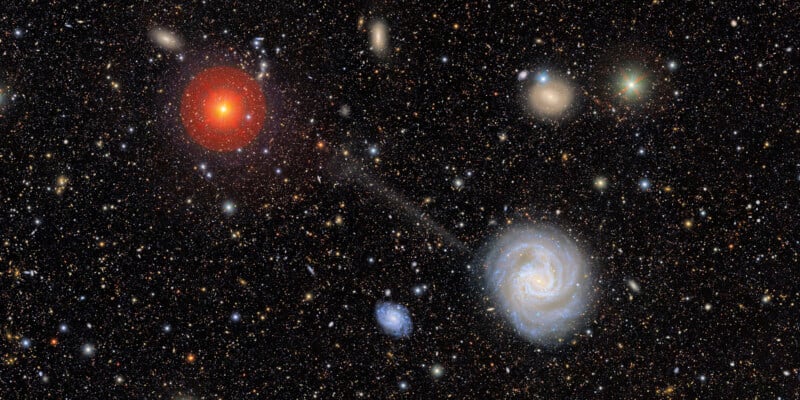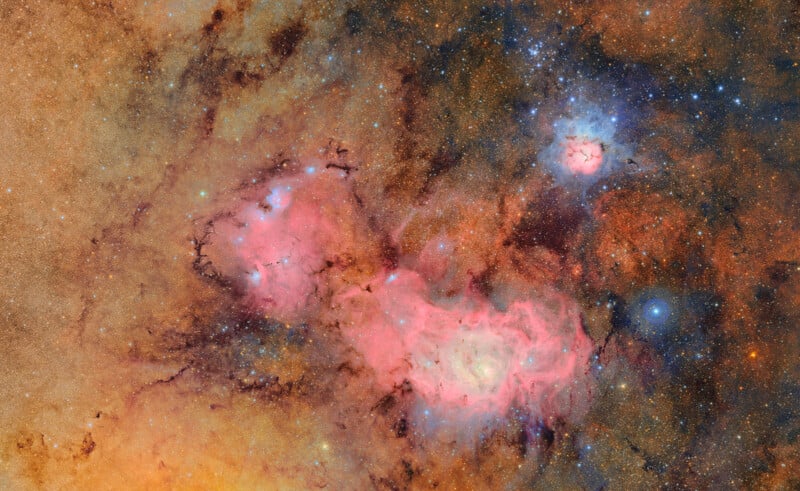Hands-On at the Vera C. Rubin Observatory and Its First Enormous 5 Gigapixel Image


Last year, PetaPixel visited the SLAC Laboratories in Stanford to go hands-on with the LSST camera module, the highest-resolution and largest camera ever constructed. Last month, the team took the long journey to the summit of Cerro Pachón in Chile to go hands-on with the finished Vera C. Rubin Observatory and see its first 5 gigapixel photo.
Today, the National Science Foundation (NSF) published the first photo captured by the new, state-of-the art observatory, which showcases more detail over a wider field of view than any other observatory before it. In a teaser published late last night and through the final materials shared this morning, the power of the Vera C. Rubin Observatory was put on full display.
But a few weeks ago, Chris Niccolls, Jordan Drake, and I saw this image in the lab and witnessed the excitement of the team there first-hand. It’s hard to capture in words how overjoyed the team is at the success of this 20 year project.



It cannot be overstated how impressive this observatory and camera system are. Looking at the initial image, this is just one small percentage of the southern sky captured over a short period. This enormous file, which has a dimension of 97,943 by 51,536 pixels (or 5.05 gigapixels), is just a sliver of what the LSST will capture over the course of the next 10 years. While PetaPixel was named after such an enormous image size as to future-proof it (a petapixel is 10 to the power of 15 pixels), that future may have come faster than we could ever have predicted. In a year, looking at just the sheer amount of image information the LSST will capture, there will be well over a petapixel catured — and this observatory plans to run for a 10-year survey, constantly capturing photos of the sky that entire time.
The Camera, The Telescope, and the Data

As we covered in detail last year, the LSST camera holds the record as the largest camera ever made. It weighs 3,000 kilograms and features an imager made up of 21 rafts, each of which holds nine CCD sensors that make up the array. To give context, one single sensor will photograph enough of the sky to contain tens of thousands of galaxies and stars at one time — and there are 189. Each of these sensors is huge, larger even than one found in a Hasselblad medium format camera, and is incredibly sensitive.

Each sensor captures a 4,000 by 4,000 pixel area, with each pixel within that being 10 microns in size, which is just under twice as large as the pixel size on the Nikon Z6 III’s 24-megapixel full-frame sensor. The diameter of the sensor area is 640mm across (about 25.2 inches) the roughly circular array. Altogether, the LSST is capable of capturing 3,200-megapixel photos which can be stacked and stitched together to create even more resolution.
“The resolution of this sensor is extraordinary. If it were aimed in the manner of a traditional camera, it could resolve a golf ball 15 miles away while also covering a swath of the sky seven times wider than the full moon,” I wrote last year.

To reduce the signal-to-noise ratio, the sensor array operates at a temperature of -100 degrees Celsius (thanks to a massive refrigeration unit that can both heat and cool to maintain equilibrium) and, to avoid condensation, does so in a complete vacuum.

The lens is, of course, also a huge feat of engineering. It has a 3.5-degree diameter field of view, which translates to about a 7.5 times wider field of view than the full moon in the night sky, and has an equivalent aperture of f/1.23. The front element has a 1.55 meter diameter, making it the largest in the world.
All of this is before it is installed into an incredibly powerful telescope system. The LSST now sits in the Simonyi Telescope inside the Vera C. Rubin Observatory. That telescope features a unique three-mirror design that gives it an exceptionally wide field of view while also maintaining a shape that allows it to move quickly.

The whole system is “floating” on a specially designed oil that reduces friction to such a degree that the Rubin Observatory team assured us that three adults could move the gigantic system with their bare hands, although they declined to let us try (for what should be obvious reasons).

The Simonyi Telescope is so advanced, it can move the LSST camera so quickly and so precisely that it is capable of capturing the entire southern sky in just three nights — and it will do this at various wavelength of light over the course of its 10 year observation.


As you can imagine, the amount of data that the LSST captures is substantial. There is so much of it that the storage capabilities of the Rubin Observatory would fill to capacity in less than a month. But not to worry, there is a physical fiber optic cable that extends 64,000 miles (103,000 kilometers) from the observatory to the SLAC Laboratory in Stanford, where new image data will arrive in a mere nine seconds after it is captured. From there, it will be transferred to the greater scientific community.
An Incredible Night of Observation
We were exceptionally lucky during our visit. For the past few weeks ahead of our arrival, the sky wasn’t playing nice. Fog, clouds, wind, and more made visibility sub-par and for several nights, the telescope wasn’t able to capture much of anything.

However, the evening of May 23, 2025 changed all of that: it was the best night for observation since the telescope had been activated — full stop. We were gifted with completely clear skies.

While the Vera C. Rubin Observatory and the LSST camera will soon start an automated capture of the entire southern sky for a 10-year period, the first images it produced as well as what it captured during our time there were for what is called “commissioning,” where the observatory targets specific tasks. Because of how good the sky would be, in the hours before sunset, the observatory team debated what it would try and do and in what order so as to maximize the data it could gather. There was no telling how long it would be able to operate (due to weather conditions and other factors), so they had to decide what to do first so as to assure the most important tasks would get completed.
By the end of the night, the full list had been completed. It was a rousing success. We left the observatory for the night well after 1 AM, but when we returned the following morning at 9 AM, the astronomers and technicians who had been running the observatory all night seemed no worse for wear; the excitement of what they were able to accomplish in one night powered them through the exhaustion.
So Much More to Come
If you watched the reveal of the first photo captured by the LSST earlier today, you would be forgiven for feeling like there wasn’t a ton of visible excitement. Scientists and engineers tend to err on the side of professionalism, leading to a tempered tone in the reveal. But rest assured, they are extremely excited about this tool and the image it captured is truly remarkable.
As Jeremy Gray reported earlier today, you really need to look at the image in all its glory to fully understand the accomplishment. This first image is not only enormous as stated above, but is absolutely chock-full of visual information. There are 10 million visible galaxies in it, and this is only about 0.05 percent of the approximately 20 billion galaxies that the Rubin Observatory will capture during its 10-year Legacy Survey of Space and Time mission.

“The first photos and videos are stellar, but just a tiny taste of what the NSF-DOE Vera C. Rubin Observatory and its new LSST camera can do. These initial images are from test captures, not a full-blown scientific study. The telescope will capture even more data with longer observations, of which it will conduct many during its 10-year mission to ‘explore and understand some of the Universe’s biggest mysteries,’” Gray explains.”




“These first photos and videos are just a tiny, albeit remarkable, glimpse at what the Rubin Observatory can achieve. Its first images are an incredible accomplishment, but one that will undoubtedly be overshadowed by countless more discoveries and achievements its dedicated team will make during the next decade.”
Again, what this telescope can do cannot be understated.
“The amount of data gathered by Rubin Observatory in its first year alone will be greater than that collected by all other optical observatories combined. This treasure trove of data will help scientists make countless discoveries about the universe and will serve as an incomparable resource for scientific exploration for decades to come,” the National Science Foundation says.

“Rubin Observatory will also be the most efficient and effective solar system discovery machine ever built. Rubin will take about a thousand images of the Southern Hemisphere sky every night, allowing it to cover the entire visible Southern sky every three to four nights. In doing so, it will find millions of unseen asteroids, comets and interstellar objects. Rubin will be a game changer for planetary defense by spotting far more asteroids than ever before, potentially identifying some that might impact the Earth or moon.”

When the 10-year observation is complete, not only will we have the highest-resolution stacked image of the night sky ever constructed, we will also have a timelapse view of the universe as it has changed over that time, giving scientists the ability to study the universe and its expansion like never before.
Per aspera ad astra.
Image credits: All photos are individually credited.
Source link


